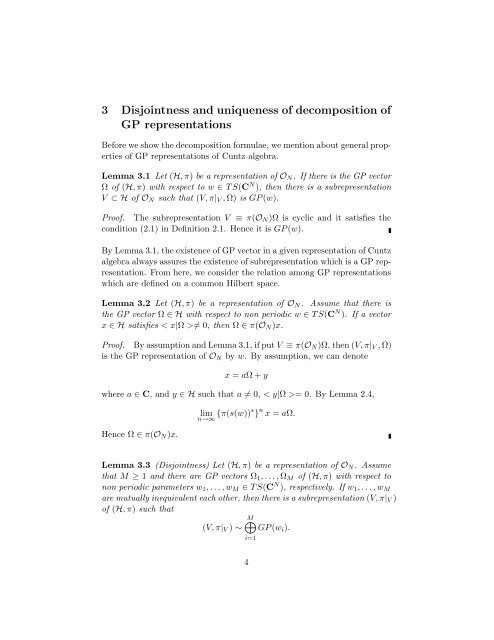Generalized permutative representation of Cuntz algebra. II ...
Generalized permutative representation of Cuntz algebra. II ...
Generalized permutative representation of Cuntz algebra. II ...
You also want an ePaper? Increase the reach of your titles
YUMPU automatically turns print PDFs into web optimized ePapers that Google loves.
3 Disjointness and uniqueness <strong>of</strong> decomposition <strong>of</strong><br />
GP <strong>representation</strong>s<br />
Before we show the decomposition formulae, we mention about general properties<br />
<strong>of</strong> GP <strong>representation</strong>s <strong>of</strong> <strong>Cuntz</strong> <strong>algebra</strong>.<br />
Lemma 3.1 Let (H, π) be a <strong>representation</strong> <strong>of</strong> O N . If there is the GP vector<br />
Ω <strong>of</strong> (H, π) with respect to w ∈ T S(C N ), then there is a sub<strong>representation</strong><br />
V ⊂ H <strong>of</strong> O N such that (V, π| V , Ω) is GP (w).<br />
Pro<strong>of</strong>. The sub<strong>representation</strong> V ≡ π(O N )Ω is cyclic and it satisfies the<br />
condition (2.1) in Definition 2.1. Hence it is GP (w).<br />
By Lemma 3.1, the existence <strong>of</strong> GP vector in a given <strong>representation</strong> <strong>of</strong> <strong>Cuntz</strong><br />
<strong>algebra</strong> always assures the existence <strong>of</strong> sub<strong>representation</strong> which is a GP <strong>representation</strong>.<br />
From here, we consider the relation among GP <strong>representation</strong>s<br />
which are defined on a common Hilbert space.<br />
Lemma 3.2 Let (H, π) be a <strong>representation</strong> <strong>of</strong> O N . Assume that there is<br />
the GP vector Ω ∈ H with respect to non periodic w ∈ T S(C N ). If a vector<br />
x ∈ H satisfies < x|Ω >≠ 0, then Ω ∈ π(O N )x.<br />
Pro<strong>of</strong>. By assumption and Lemma 3.1, if put V ≡ π(O N )Ω, then (V, π| V , Ω)<br />
is the GP <strong>representation</strong> <strong>of</strong> O N by w. By assumption, we can denote<br />
x = aΩ + y<br />
where a ∈ C, and y ∈ H such that a ≠ 0, < y|Ω >= 0. By Lemma 2.4,<br />
Hence Ω ∈ π(O N )x.<br />
lim<br />
n→∞ {π(s(w))∗ } n x = aΩ.<br />
Lemma 3.3 (Disjointness) Let (H, π) be a <strong>representation</strong> <strong>of</strong> O N . Assume<br />
that M ≥ 1 and there are GP vectors Ω 1 , . . . , Ω M <strong>of</strong> (H, π) with respect to<br />
non periodic parameters w 1 , . . . , w M ∈ T S(C N ), respectively. If w 1 , . . . , w M<br />
are mutually inequivalent each other, then there is a sub<strong>representation</strong> (V, π| V )<br />
<strong>of</strong> (H, π) such that<br />
M⊕<br />
(V, π| V ) ∼ GP (w i ).<br />
i=1<br />
4
















